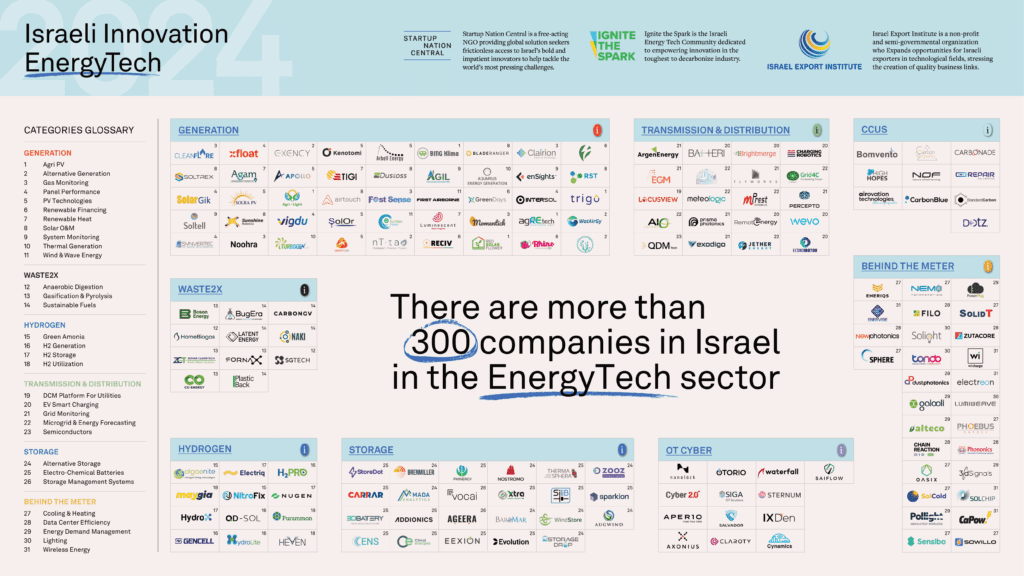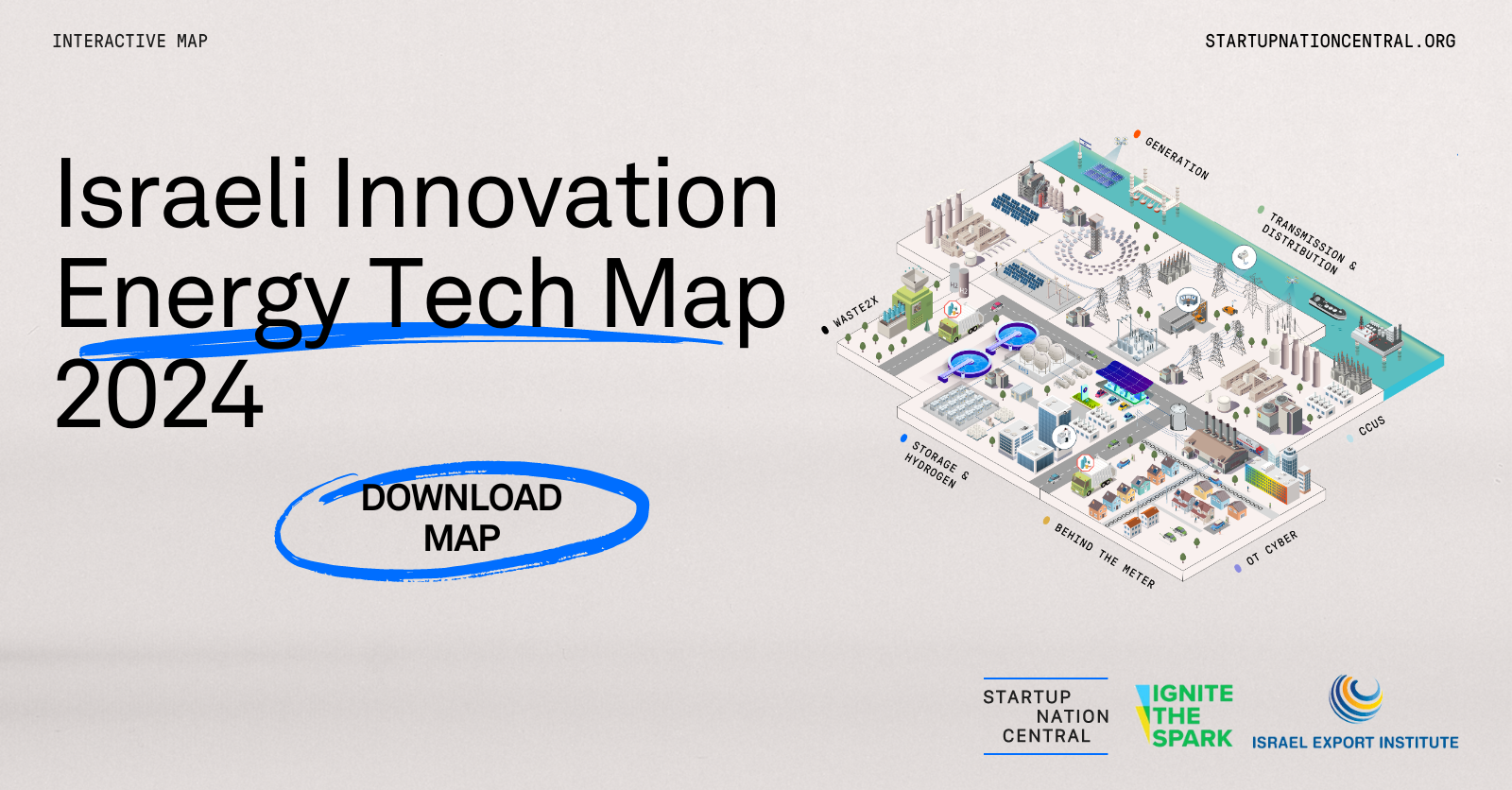The world is at a pivotal moment in moving to a more sustainable and low-carbon future.
The energy sector, responsible for over 70% of global greenhouse gas emissions, is a key driver of this transition. The push for cleaner energy systems and technologies is driven by climate change concerns and the need for energy security and affordability.
Energy tech, a subsector of climate tech, is the response to this demand.
Advanced low-carbon energy systems are integral to climate transition and impact many industries. From transportation to manufacturing, construction, and building management, markets seeking energy tech innovation have surpassed the traditional energy sector, presenting significant opportunities for investors, innovators, and other global players.
The Startup Nation: disrupting the energy tech sector
As the world becomes restless for sustainable energy solutions, Israel’s approach to innovation is increasingly important—we call this approach “Impatient Innovation.” Recognizing this opportunity, Israeli entrepreneurs are delivering innovative solutions to disrupt all new energy value chain verticals.
The Israeli energy tech ecosystem has grown significantly recently, with many new startups and established companies working on low-carbon energy systems. There are currently over 300 companies in the sector.
The sector has also reached a mature stage, with approximately 40% of companies advancing to late-stage development, which signifies ample opportunities for business engagement.
From improved renewable energy sources to smart grid management, energy storage, energy efficiency, waste-to-energy, hydrogen, carbon mitigation, and more, Israel is at the forefront of the global energy transition.
Main players and big wins in Israeli energy tech 2024
Key data:
- $403M raised in the last 12 months; 54 rounds
- 11 rounds amounting to over $10M*; largest round $105M
- 60% early stage/growth (pre-seed – B); 40% late stage/mature
- 70% were established in the last 10 years
- There are 300 companies in the Israeli energy tech sector
- There are 160 companies featured on the map
- 10 new companies created in the last 12 months
Special mentions:
- Rivage Investment invested €150 million in debt financing in Econergy. This investment aims to support Econergy’s pipeline of renewable energy projects across Europe and enhance its capacity to develop sustainable energy solutions.
- Dragones Venture Partners invested XtraLit as Part of Series B. The funding will bolster XtraLit’s rollout of its Direct Lithium Extraction (DLE) technology in Argentina, aiding its expansion efforts to improve lithium extraction efficiency.
- Clean Energy Ventures and UM6P Ventures invested in Nitrofix as part of the Seed round. The investment is intended to support Nitrofix’s innovative technology for producing green ammonia using an electrochemical process, contributing to more sustainable ammonia production methods.
Israel Energy Tech Landscape Map 2024
Startup Nation Central, Ignite the Spark, and the Israel Export Institute produce an energy tech landscape map every year to highlight the breadth and depth of the Israeli energy tech ecosystem.
The 2024 map features over 160 innovative companies that are the backbone of the Israeli energy tech sector. It is dynamic and split into subsectors, making it an easy-to-use tool for learning about the Israeli energy technology ecosystem—just click and explore!
Global investors can use the map to identify deal flow, while multinational corporations can find solutions to their pain points and decarbonization targets. Keep reading for a breakdown of all the map’s subsectors.


Energy tech subsectors and emerging technologies
This brief overview of the eight energy tech subsectors featured in the landscape map highlights the contributions of Israel’s bold and determined approach to innovation.
Generation
The process of producing energy (electricity or heat) from different primary sources. Innovative technologies propel the adoption of renewable energy sources such as wind, solar, and hydropower instead of non-renewable (and carbon-heavy) fossil fuels. These technologies have seen significant growth in recent years as the demand for clean energy has increased.
Storage
The process of capturing and storing energy for later use. The most common system to save energy today is based on electrochemical batteries, but new technologies are slowly showing promising results, including improved LCOS. Some other alternatives to conventional batteries are pumped hydro storage, which uses excess energy to pump water uphill to a storage reservoir and then releases it to generate electricity when needed, and thermal energy storage, which stores heat or cold for later use. Large-scale battery storage is one emerging trend in this subsector, enabling the modern grid to be further decarbonized with unprecedented storage volumes.
Behind the Meter
Technologies associated with consumer-based electricity consumption (and use of other forms of energy). Innovation related to Behind the Meter applications impacts the output of energy from consumers, optimizing the energy needed for appliances and other consumer goods to perform work. This subsector includes electric vehicles, which are becoming more affordable and efficient, wireless energy, which replaces physical infrastructure, smart buildings, which use sensors and automation to optimize energy use, and efficient appliances and lighting.
Transmission and Distribution
Energy (specifically electricity) is delivered from the generation source to the end user through transmission and distribution networks. Sustainability-focused technology in this subsector includes grids monitored with a digital twin using advanced sensors, analytics, and automation to optimize energy distribution. Microgrids are small-scale power grids that can operate independently or in conjunction with the main power grid and can better integrate local renewable energy sources and storage systems.
Hydrogen
This clean energy carrier can be produced carbon-free through water using renewable energy sources such as solar or wind power (or as an output of a Waste2X facility). Hydrogen has potential applications in transportation, power generation, and industrial processes—and it is a silver bullet for the decarbonization of hard-to-abate sectors and industries. Examples of emerging technologies in this subsector utilize innovative hydrogen fuel cells, which convert hydrogen into electricity and produce only water as a byproduct, and develop novel methods for safe, long-term storage of hydrogen molecules.
OT Cyber
This subsector includes cybersecurity measures and technologies that protect operational technology (OT) systems, such as those used in the energy sector, from cyber-attacks and other security threats. Blockchain can provide secure and transparent data sharing and transactions between energy producers and consumers, and artificial intelligence (AI), which can be used to monitor and detect cyber threats in real-time, are some technologies being leveraged for OT Cyber Tech. Other developments include protecting distributed energy resources (DERs) such as rooftop solar panels and home batteries, which are an integral part of the grid and are controlled remotely, making these more vulnerable.
Carbon Capture, Utilization, and Sequestration
Reaching global warming targets requires more than electrifying today’s carbon-emitting industries. Some emissions cannot be controlled. We need negative carbon dioxide emissions to neutralize greenhouse gases to compensate for these uncontrolled and unforeseen GHG emissions. While some carbon can be sequestered for an indefinite time, CO2 can also be used for other purposes, such as as a green feedstock. Solutions in this subsector focus on using green energy as the main power source for CCUS processes.
Waste2X
For years, waste has been a burden and has caused environmental challenges and extensive pollution. By harnessing novel technologies like anaerobic, digestion, pyrolysis, and gasification, both organic and inorganic waste can now be reused and become a sustainable source of electricity, hydrogen, and E-fuels
Energy tech definitions
- Broad Definition: Companies for which energy tech is one of their use cases, totaling 300.
- Narrow Definition: Companies for which energy tech is their primary use case/primary sector, totaling 210.
- Map Definition: These broadly defined “all stars” made the map.
Broad Definition Case Studies:
Example #1: Heven Drones
Primary Sector: Aerospace & Aviation
Heven Drones primarily makes drones, which are not strictly “energy technology” products. However, they use hydrogen fuel cells to power these drones. Hydrogen fuel is considered an advanced energy technology because it’s a clean and efficient power source. Since Heven Drones incorporates this technology, they fit the broad definition of “Energy Tech”. This shows that even companies not solely focused on energy can still play a significant role in the energy tech landscape by integrating these technologies into their products.
Example #2: Rhino Eco
Primary Sector: Fintech
Rhino Eco is a fintech company focused on the solar panels industry. It provides financing solutions that make investing in solar projects easier for companies and individuals. This is crucial for expanding renewable energy adoption, as financing can often be a barrier.
Delivering energy tech solutions, no matter what
Despite global and local challenges, the Israeli tech ecosystem demonstrates remarkable resilience. Many companies have persevered and thrived, with last year’s players still strong and newcomers raising capital and entering the map.
The 2024 Energy Tech Landscape Map reflects the rapid pace of innovation in the Israeli energy tech ecosystem across various verticals with useful interactive information on each subsector.
